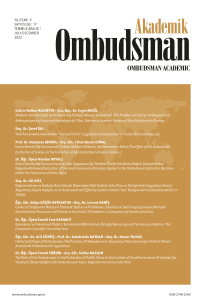Öz
Kaynakça
- References • İBA, Şeref (2007), Osmanlı’dan Günümüze Meclis İçtüzük Metinleri, Ankara, TBMM Basımevi
- • İBA, Şeref (2008), “Türk Parlamento Hukukunda “Yasama İşlemi” ve “Karar” Kavramları”, Prof. Dr. Ergun Özbudun Armağanı, Ankara, Yetkin Yayınevi, Cilt:2, s.399-420.
- • İBA, Şeref (2018), Türk Anayasa Hukuku, Ankara, Turhan Kitabevi.
- • İBA, Şeref (2020) “Türk Parlamento Tarihinde II. Meclis”, Yüzüncü Yılında TBMM-Oluşumu, Çalışma Şartları ve İşlevleri (Ed. Prof. Dr. Yusuf Tekin), Cilt:1, TBMM Basımevi, 1. Baskı.
- • İBA, Şeref (2021), “1924 Anayasasının Hazırlık ve Kanunlaşma Süreci Üzerine”, Yasama Dergisi, Sayı:44.
- • İBA, Şeref (2022), Anayasa Dersleri, Ankara, Turhan Kitabevi, 4. Baskı.
- • KILIÇ, Abbas (2020), Türkiye’de Parlamento Kararlarının Hukuki Rejimi, Ankara, Adalet Yayınevi, s.187.
- • KÖKÜSARI, İsmail (2018), “Osmanlı-Türk Anayasal Tarihinde Yasama Yorumu ve Uygulaması”, A.Ü. Hukuk Fakültesi Dergisi, Cilt: 67, Sayı: 4, s. 807-855.
- • TEZİÇ, Erdoğan (2012), Anayasa Hukuku, İstanbul, Beta, s.34.
- • YAYLA, Yıldızhan (1986), Anayasa Hukuku Ders Notları, İstanbul, Filiz Kitabevi, s. 161.
- • TDK Güncel Sözlük, (https://sozluk.gov.tr/) (erişim tarihi:30.12.2021)
- • 16.5.1942 tarihli ve 1284 sayılı TBMM Kararı için bkz. Kanunlar Dergisi, Cilt:23, s.1028-1030.
- • “Tefsir No.203” için bkz. Resmi Gazete, 9 Aralık 1934 (Sayı:2875)
- • 1961 Anayasası Tasarısı ve Anayasa Komisyonu Raporu, S. Sayısı: 09.03.1961
- • Meclis-i Ayan Zabıt Ceridesi, Devre:1, Cilt:1, İçtima Senesi:3, 14 Şubat 1326, s.550-562.
- • TBMM Zabıt Ceridesi, Devre:2, İçtima:93, Celse:1, Cilt:5, 31 Kanunusani 1340, s.488-489.
- • Temsilciler Meclisi Tutanak Dergisi, (S. Sayısı:35), B.34, 30.3.1961
- • Anayasa Mahkemesi Kararı, E.1977/6, K.1977/4, Kt.22.2.1977.
- • Anayasa Mahkemesi Kararı, E.1967/10, K.1967/49, Kt:28.12.1967
- • Anayasa Mahkemesi Kararı, E.1992/26, K.1992/48, Kt:17.09.1992
- • Kurucu Meclis Kararı, (No.51, Resmi Gazete 12. Mayıs 1961 (Sayı:10805)
Öz
In our legal history, tradition of legislative interpretation, starting from the period of 1876 Constitution with the Heyet-i Ayan, ended with the Constitution of 1961. Accordingly, the application of legislative interpretation has been formed as not limited to the making sense of laws in the narrow sense. In this tradition, legislative interpretation has been understood in a broad sense as the interpretation of all legislative acts covering Constitution, laws and equivalent provisions of laws and rules of procedure of the Parliament,
and has been consulted frequently as an easily functioning legislative system. The narrow framework defined in constitutions as the authority of "interpretation of laws" has been exceeded and legislative activity has been carried out through interpretation on all legislative acts in force. Thus, it is necessary to consider the concept of interpretation in a broad framework related to the legislative acts that have been already made and are in force. In Turkish parliamentary law, legislative interpretation that has become one of the main tools of the legislative power in terms of its supremacy over the executive and the judiciary, was abolished with the 1961 Constitution in line with the developments and practices in comparative parliamentary and constitutional law.
Anahtar Kelimeler
Legislative interpretation Indirect interpretation Direct interpretation Legislative power Legislative activity
Kaynakça
- References • İBA, Şeref (2007), Osmanlı’dan Günümüze Meclis İçtüzük Metinleri, Ankara, TBMM Basımevi
- • İBA, Şeref (2008), “Türk Parlamento Hukukunda “Yasama İşlemi” ve “Karar” Kavramları”, Prof. Dr. Ergun Özbudun Armağanı, Ankara, Yetkin Yayınevi, Cilt:2, s.399-420.
- • İBA, Şeref (2018), Türk Anayasa Hukuku, Ankara, Turhan Kitabevi.
- • İBA, Şeref (2020) “Türk Parlamento Tarihinde II. Meclis”, Yüzüncü Yılında TBMM-Oluşumu, Çalışma Şartları ve İşlevleri (Ed. Prof. Dr. Yusuf Tekin), Cilt:1, TBMM Basımevi, 1. Baskı.
- • İBA, Şeref (2021), “1924 Anayasasının Hazırlık ve Kanunlaşma Süreci Üzerine”, Yasama Dergisi, Sayı:44.
- • İBA, Şeref (2022), Anayasa Dersleri, Ankara, Turhan Kitabevi, 4. Baskı.
- • KILIÇ, Abbas (2020), Türkiye’de Parlamento Kararlarının Hukuki Rejimi, Ankara, Adalet Yayınevi, s.187.
- • KÖKÜSARI, İsmail (2018), “Osmanlı-Türk Anayasal Tarihinde Yasama Yorumu ve Uygulaması”, A.Ü. Hukuk Fakültesi Dergisi, Cilt: 67, Sayı: 4, s. 807-855.
- • TEZİÇ, Erdoğan (2012), Anayasa Hukuku, İstanbul, Beta, s.34.
- • YAYLA, Yıldızhan (1986), Anayasa Hukuku Ders Notları, İstanbul, Filiz Kitabevi, s. 161.
- • TDK Güncel Sözlük, (https://sozluk.gov.tr/) (erişim tarihi:30.12.2021)
- • 16.5.1942 tarihli ve 1284 sayılı TBMM Kararı için bkz. Kanunlar Dergisi, Cilt:23, s.1028-1030.
- • “Tefsir No.203” için bkz. Resmi Gazete, 9 Aralık 1934 (Sayı:2875)
- • 1961 Anayasası Tasarısı ve Anayasa Komisyonu Raporu, S. Sayısı: 09.03.1961
- • Meclis-i Ayan Zabıt Ceridesi, Devre:1, Cilt:1, İçtima Senesi:3, 14 Şubat 1326, s.550-562.
- • TBMM Zabıt Ceridesi, Devre:2, İçtima:93, Celse:1, Cilt:5, 31 Kanunusani 1340, s.488-489.
- • Temsilciler Meclisi Tutanak Dergisi, (S. Sayısı:35), B.34, 30.3.1961
- • Anayasa Mahkemesi Kararı, E.1977/6, K.1977/4, Kt.22.2.1977.
- • Anayasa Mahkemesi Kararı, E.1967/10, K.1967/49, Kt:28.12.1967
- • Anayasa Mahkemesi Kararı, E.1992/26, K.1992/48, Kt:17.09.1992
- • Kurucu Meclis Kararı, (No.51, Resmi Gazete 12. Mayıs 1961 (Sayı:10805)
Ayrıntılar
| Birincil Dil | Türkçe |
|---|---|
| Bölüm | OMBUDSMAN AKADEMİK 17. SAYI |
| Yazarlar | |
| Erken Görünüm Tarihi | 17 Ocak 2023 |
| Yayımlanma Tarihi | 22 Ocak 2023 |
| Kabul Tarihi | 17 Ocak 2023 |
| Yayımlandığı Sayı | Yıl 2022 Sayı: 17 |


